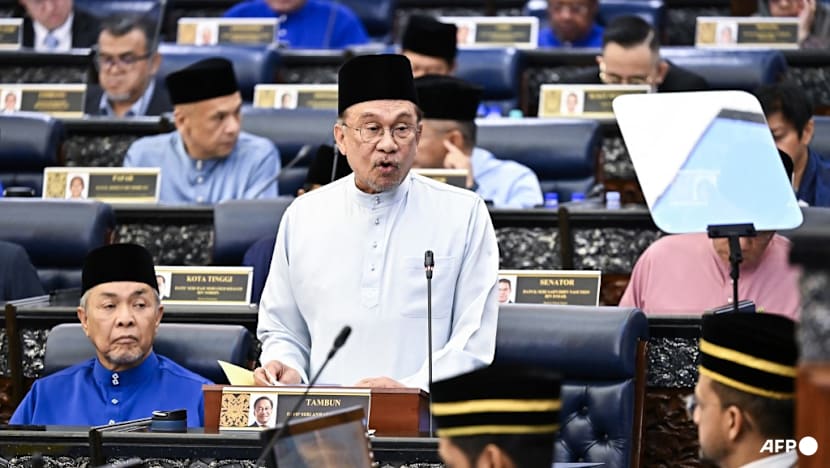Commentary: Malaysia’s Budget 2026 could have done more to answer its own warnings about the future
Amid a global economy gripped with uncertainty, Malaysia’s Budget 2026 provides little reassurance that policies are adapting fast enough to weather the storm, says Stewart Nixon from Malaysian think tank IDEAS.

Malaysian Prime Minister Anwar Ibrahim delivering his Budget 2026 at the Parliament in Kuala Lumpur on Oct 10, 2025. (Photo: AFP/Nazri Rapaai/Dapartment of Information)

This audio is generated by an AI tool.
KUALA LUMPUR: “The world is evolving at breakneck speed and we endanger our future by not keeping pace.” So said Malaysian Prime Minister Anwar Ibrahim as he tabled Budget 2026 in parliament on Friday (Oct 10).
For all of Mr Anwar’s characteristically steady yet captivating delivery, the budget stood out more for what it left out, rather than what it included. Amid a global economy gripped with uncertainty, it provided little reassurance that policies are adapting fast enough to weather the storm.
The government deserves credit for resisting the temptation to overspend. Inflation is contained, unemployment is at its lowest in a decade and economic growth is resilient. This context explains the absence of big-ticket policies. But a budget that neither builds fiscal buffers nor meaningfully increases investment in future productivity leaves Malaysia exposed amid heightened volatility.
It was surprisingly quiet on external headwinds and lacked a fulsome strategy to build economic resilience or shore up long-term revenue amid rising geoeconomic, geopolitical and climate threats.
FISCAL CAUTION WITHOUT LONG-TERM PLANNING
Now in his third year as prime minister, Mr Anwar has projected a record RM470 billion (US$111 billion) in spending for 2026. However, this figure includes RM50.8 billion in allocations from government-linked and state-owned bodies - expenditure typically not included in a budget sum.
The fiscal deficit is expected to narrow to 3.8 per cent of GDP this year and 3.5 per cent next year, continuing its decline from 4.1 per cent in 2024 and 5 per cent in 2023. While predictability may reassure ratings agencies and international investors, a seeming unresponsiveness to long-term economic developments undermines resilience.
Keeping with recent tradition, total government revenue is set to grow more slowly than Malaysia’s economy. Revenue may be expanding on paper but it is shrinking in relative terms, reducing the government’s spending power. The only years this decade in which revenue growth exceeded economic growth were when the government levied extraordinary dividends on Petronas and Bank Negara. Those are now falling. Petronas paid a RM50 billion dividend in 2022 and is expected to deliver just RM20 billion in 2026.
Tax collections are rising faster than economic growth, but driven mostly by improved enforcement. The Budget highlights ongoing efforts to reduce tax leakage by tackling circumvention and corruption. These efforts are commendable but insufficient.
What’s missing are tax policy reforms. The government has not been able to find the political nuance to advance policies that increase and diversify the tax base.
The longer this delay continues, the more difficult it will be to meet growing fiscal demands tied to an ageing population and a growing middle class.
FROM SUBSIDY REFORM TO ENTRENCHMENT?
This time last year, Mr Anwar described subsidies as “akin to charity” in his Budget 2025 speech. He promised “a bold approach … pivoting towards targeted subsidies”. Progress since has been less ambitious than hoped, highlighted by a Budi95 scheme that only excludes foreigners and large companies from petrol subsidies - and for which implementation has serious leakage risks and entrenches cheap and near uncapped use of fossil fuels.
In advancing subsidy reform under a new “excluding foreigners” narrative, Budget 2026 unwittingly entrenches subsidies as “a right and privilege for Malaysians”. Such language closes space for subsidy rationalisation and reform.
And a rationalisation of tax incentives requiring high-growth, high-value employment outcomes from foreign investors appears to have been delayed, suggesting these too are proving sticky.
PUTRAJAYA’S GRIP ON BUDGETING
Budget 2026 will be remembered not for big spending initiatives but for the absence of boldness. The combination of federal government dominance of total revenue collection in Malaysia and its inability to increase and diversify revenue is on full display in its modest and increasingly localised budget measures.
The Madani economy framework - which aims to empower and rejuvenate Malaysia’s economy within 10 years - pursues worthwhile initiatives to promote inclusion by uplifting villages, rural communities, remote schools and needy households. But delivery from Putrajaya illustrates how centralised and top-down Malaysian policy is.
Nothing in Budget 2026 suggests fiscal decentralisation is on the cards, with grants and transfers to subnational governments continuing at just 2.8 per cent to 2.9 per cent of federal operating expenditure. This must change if Malaysia is serious about supporting inclusive development tailored to local needs.
Returning to future-proofing, the Budget could have done more to invest in future industries, social inclusion and climate readiness.
Development expenditure is projected to fall from 4.4 per cent to 3.8 per cent of GDP by 2026. This is hard to square with the need to upgrade public services, strengthen digital infrastructure and prepare for a green transition. Spending on education and health development appears set to fall too, while climate adaptation expenditure remains a flood-focused budget footnote.
To its credit, the government is pursuing several initiatives that target both immediate and future productivity and inclusion gains - both new and reannounced in the budget. These include tax deductions for training in AI and cybersecurity, finance for semiconductor and digital industry partnerships, tax relief for childcare, youth entrepreneurship schemes, and capital and guarantees for business start-ups.
Budget 2026 was the first under the 13th Malaysia Plan - an outline of government development policies over a five-year period - which was tabled in Parliament in July. It could have been used to signal funding for long-term reforms. Yet, it didn’t.
Malaysia’s challenges are significant and complex, and no single budget can provide all the answers. But in an increasingly uncertain external environment, facing significant political and fiscal constraints and competing demands, the result is a small-target approach.
This budget provides more of the same in a world experiencing unprecedented change. Future budgets cannot afford to avoid bolder choices.
Dr Stewart Nixon is the Deputy Director, Research at IDEAS (The Institute for Democracy and Economic Affairs) Malaysia.



















